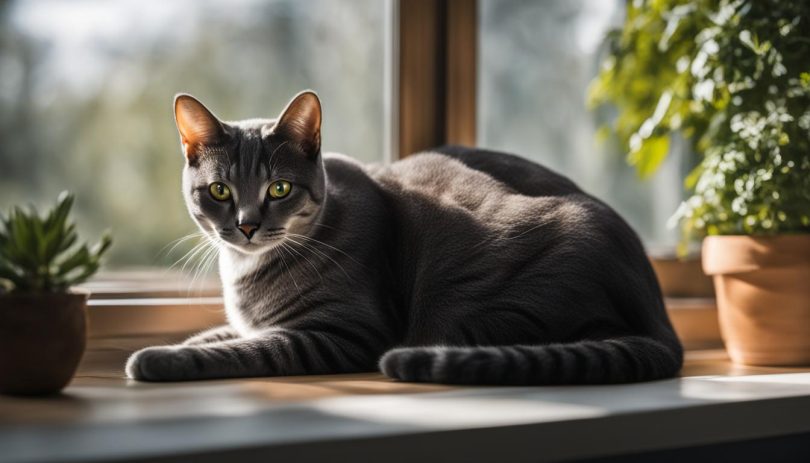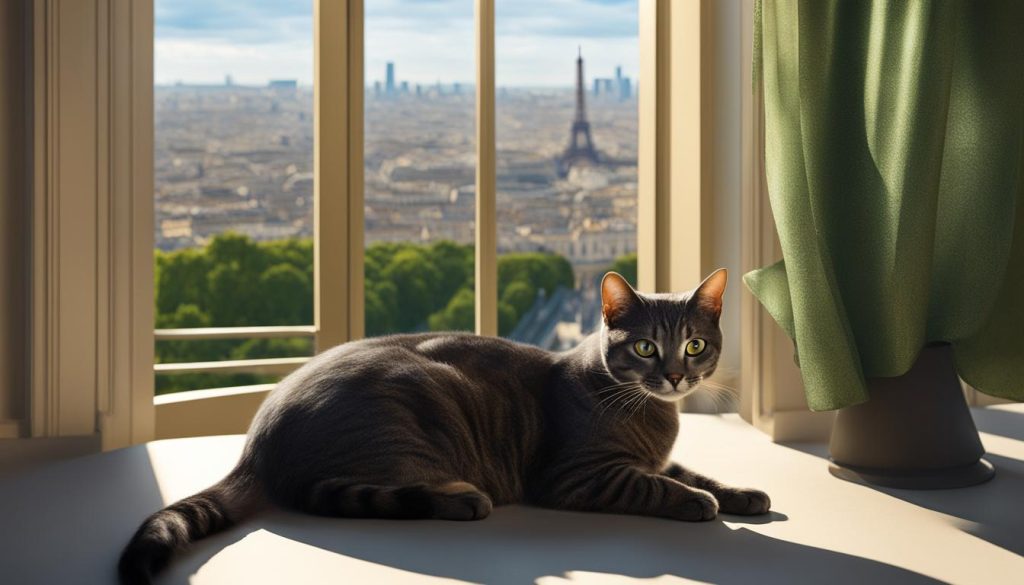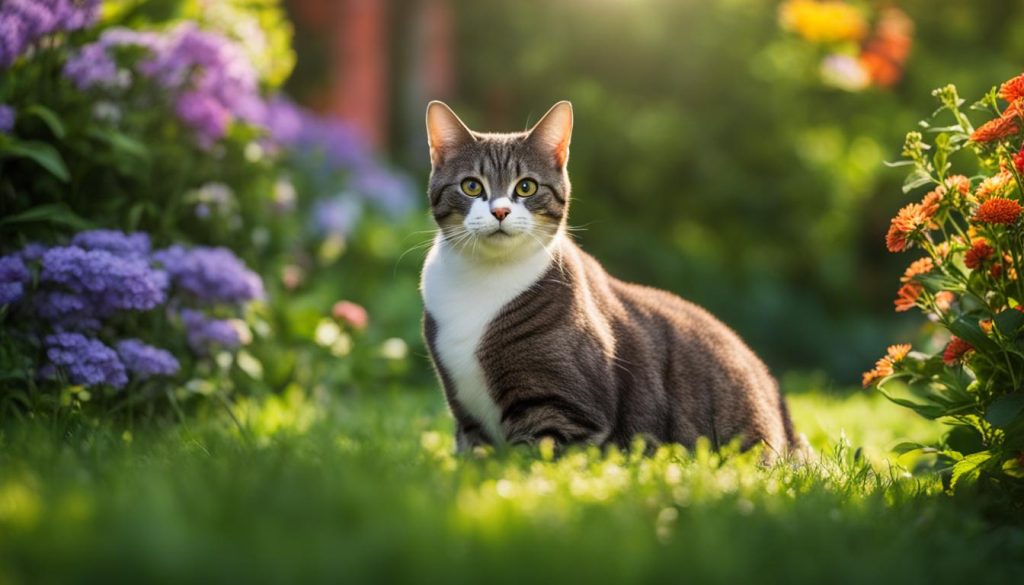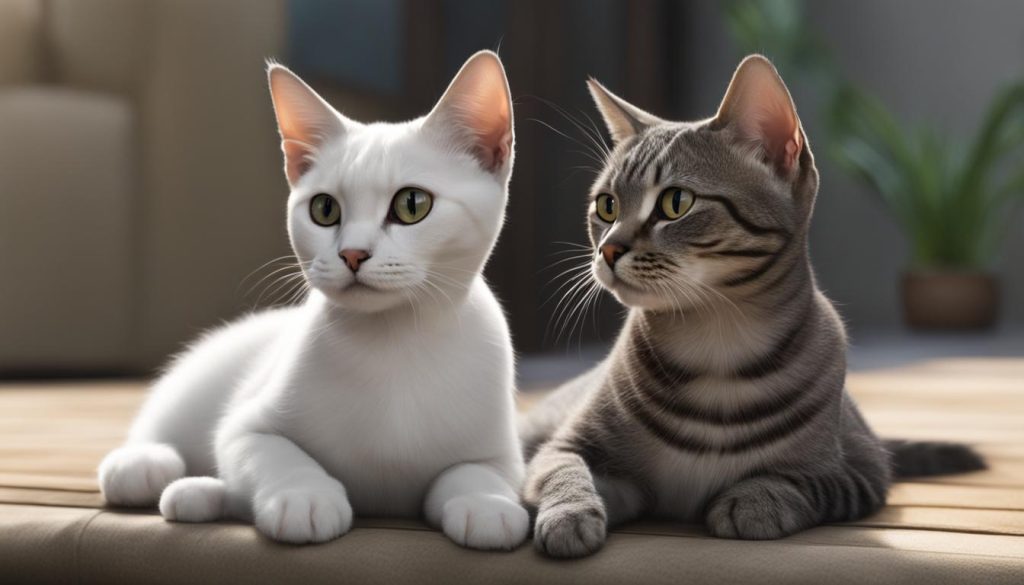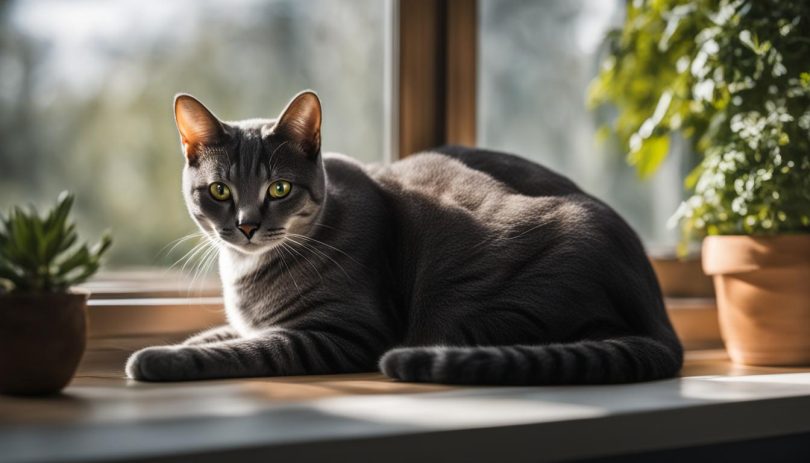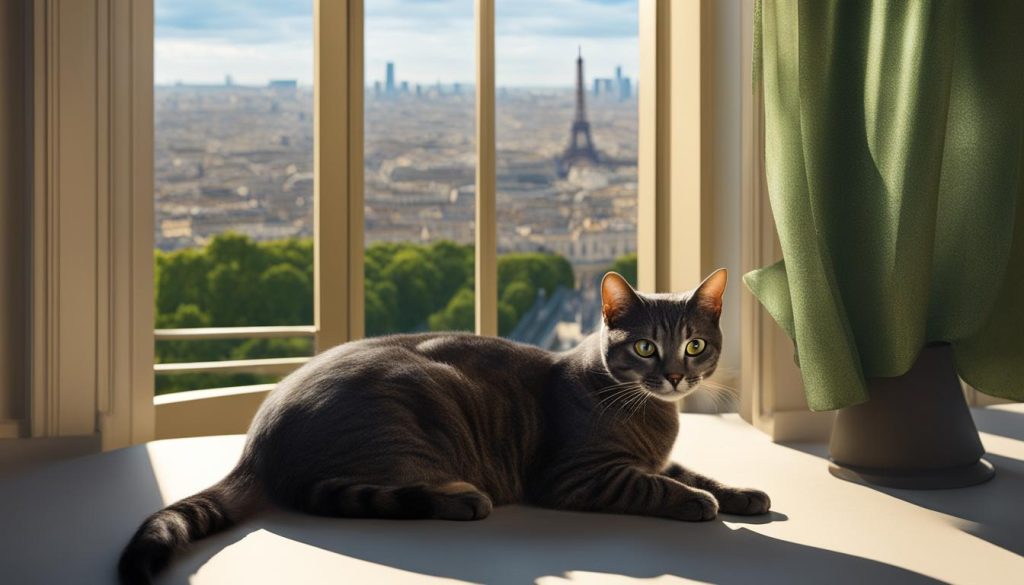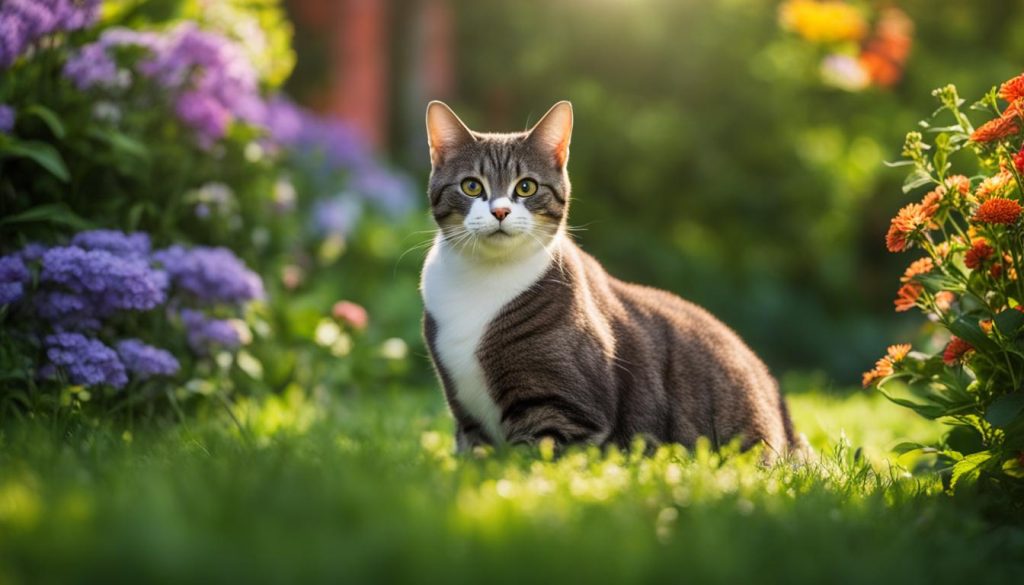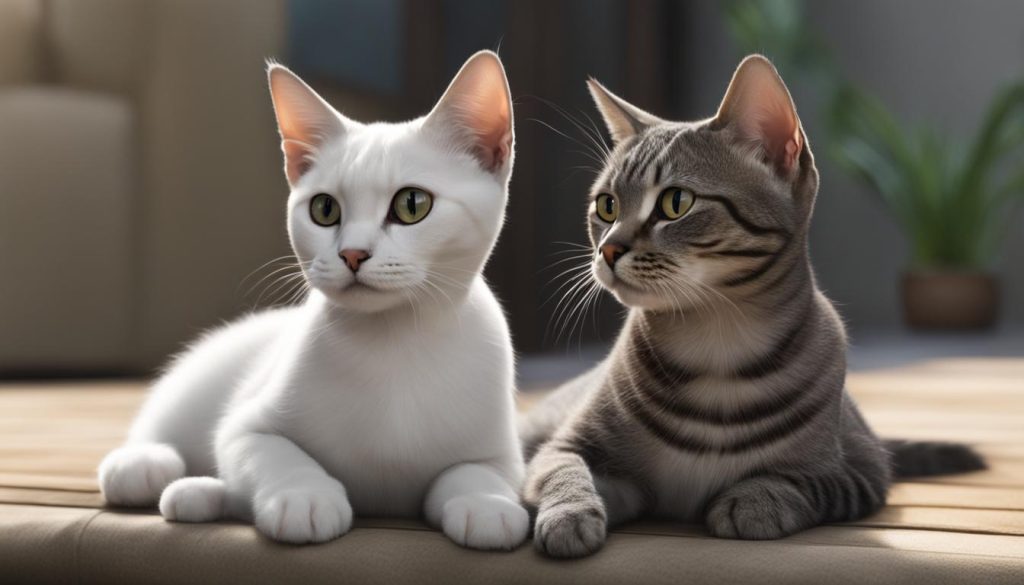I am excited to share with you an in-depth guide on the life expectancy of European Shorthair cats. If you’re considering welcoming a European Shorthair into your home or simply want to learn more about this fascinating breed, you’ve come to the right place.
The European Shorthair is renowned for its intelligence, loyalty, and adaptability, making it an ideal companion for individuals of all ages. But how long do these magnificent felines typically live? Let’s delve into the details and unravel the mysteries of their lifespan.
Key Takeaways:
- The average lifespan of European Shorthair cats is generally between 15 and 20 years.
- European Shorthairs have a robust, muscular build and come in various colors and patterns.
- They are known for their playful, kitten-like attitude and hunting skills.
- The breed has a long history, being a direct descendant of ancient Rome’s common domestic cat.
- To ensure their health and longevity, European Shorthairs require a high-quality diet, regular grooming, and routine veterinary care.
Physical Appearance and Coat of the European Shorthair
The physical appearance of European Shorthairs is characterized by their medium-to-large size and robust, muscular build. They have slightly rounded skulls, well-developed cheeks, and tails that are thick at the base and taper to a rounded tip. The breed’s ears are tall and as wide as they are long, with slightly rounded tips. However, it is their eyes that truly captivate, as European Shorthairs have medium-to-large round eyes that come in various colors such as green, amber, blue, or odd eye (one blue and one amber).
The coat of a European Shorthair is a defining feature. It is glossy, dense, and close-lying, with little undercoat. This coat type makes grooming relatively easy, as it is less prone to matting. European Shorthairs come in a wide variety of colors and patterns, adding to their unique charm and appeal. However, it is important to note that not all colors and patterns are included in the breed standard, which sets the guidelines for show cats.
To summarize, the European Shorthair’s physical appearance is characterized by their medium-to-large size, robust build, slightly rounded skulls, well-developed cheeks, and captivating eyes. Their coat is glossy, dense, and close-lying, with little undercoat. They come in a variety of colors and patterns, although not all are recognized in the breed standard.
Temperament and Behavior of European Shorthairs
European Shorthairs are known for their friendly and adaptable nature, making them wonderful companions in any household. They have a playful and kitten-like attitude that lasts throughout their lives, bringing joy and entertainment to their owners. These cats are highly intelligent and enjoy interactive toys and mental stimulation.
While European Shorthairs may be initially shy around strangers, they quickly warm up with time and form deep bonds with their owners. They are loyal and affectionate, seeking companionship and social interaction. These cats get along well with other cats, people of all ages, and even respectful dogs.
With their hunting instincts, European Shorthairs may display their skills by chasing and hunting small animals if given the opportunity. It’s important to provide them with appropriate outlets for their natural behaviors, such as interactive toys and scratching posts.
Personality of European Shorthairs
European Shorthairs have a distinct personality that sets them apart from other cat breeds. They are generally independent and have a reserved nature, often observing their surroundings before engaging. However, once they feel safe and comfortable, they become affectionate and loving companions.
These cats have a calm and composed demeanor, making them an ideal choice for individuals seeking a relaxed and easy-going pet. They are not excessively demanding and are content with quality time spent with their owners.
The personality of a European Shorthair can vary slightly from cat to cat, but overall, they are known for their adaptable and friendly nature, making them a delightful addition to any household.
| Traits | Description |
|---|---|
| Playfulness | European Shorthairs maintain a playful attitude throughout their lives, enjoying interactive toys and games. |
| Intelligence | These cats are highly intelligent and easily learn new tricks and behaviors. |
| Loyalty | European Shorthairs form deep bonds with their owners and are loyal companions. |
| Adaptability | They are adaptable to different environments and get along well with other cats and dogs. |
| Independent | While they enjoy their owner’s company, European Shorthairs also appreciate their independence and alone time. |
As with any cat, individual personalities may vary, but the European Shorthair breed generally exhibits these traits. Understanding their temperament and behavior can help provide them with the love, care, and environment they need to thrive.
History and Origins of the European Shorthair
The European Shorthair breed has a rich history that dates back to ancient times. Its origins can be traced to the common domestic cats that accompanied Roman soldiers in ancient Rome. These cats played a vital role in controlling vermin in early settlements and were prized for their hunting skills. Over the centuries, these cats bred naturally and developed into the European Shorthair we know today.
The breed’s development took a significant step forward in the 20th century when Swedish breeders created the first breed standard. This standard provided guidelines for the physical characteristics and traits that define the European Shorthair. It wasn’t until 1992 that the breed was officially recognized by the Federation Internationale Féline (FIFe).
While the European Shorthair is not recognized by U.S. cat clubs, it remains a popular breed in Scandinavia and holds the distinction of being the national cat of Finland. Its history and origins make it a fascinating breed with ties to ancient Rome and a testament to the enduring qualities that have made it a beloved companion throughout the ages.
European Shorthair History Timeline:
| Timeline | Event |
|---|---|
| Ancient Rome | Common domestic cats accompany Roman soldiers. |
| 20th Century | Swedish breeders create the first European Shorthair breed standard. |
| 1992 | Federation Internationale Féline (FIFe) officially recognizes the European Shorthair. |
| Present | European Shorthair remains a popular breed in Scandinavia and is the national cat of Finland. |
With its historical significance and enduring charm, the European Shorthair continues to captivate cat lovers around the world.
Care and Nutrition for European Shorthairs
Proper care and nutrition are essential for ensuring the health and well-being of European Shorthairs. By providing them with a balanced diet, regular grooming, and routine veterinary care, you can help promote their overall health and longevity.
When it comes to nutrition, it’s important to choose a high-quality cat food that is specifically formulated for European Shorthairs. Look for a diet that is rich in animal-based protein and contains essential nutrients such as omega-3 fatty acids, vitamins, and minerals. Avoid foods with excessive fillers and artificial additives.
Grooming plays a crucial role in maintaining the coat and overall cleanliness of European Shorthairs. Regular brushing helps remove loose hair, prevents matting, and stimulates blood circulation. Additionally, it helps reduce hairballs and promotes a healthy skin and coat. Remember to trim their nails regularly to prevent overgrowth and check their ears for any signs of infection.
Regular veterinary check-ups are vital for monitoring the health of European Shorthairs. During these visits, your veterinarian can perform a thorough examination, administer vaccinations, and provide preventive care such as flea and tick control. They can also conduct genetic testing to identify any potential health conditions and develop a suitable treatment plan if needed.
| Aspect | Guidelines |
|---|---|
| Diet | Choose a high-quality cat food that is specifically formulated for European Shorthairs, rich in animal-based protein, and free from fillers and artificial additives. |
| Grooming | Regularly brush their coat to remove loose hair, prevent matting, and stimulate blood circulation. Trim their nails and check their ears for infections. |
| Veterinary Care | Schedule regular check-ups with a veterinarian to monitor their health, administer vaccinations, and conduct genetic testing if necessary. |
By following these care and nutrition guidelines, you can ensure that your European Shorthair remains healthy and happy throughout their life. Remember to provide them with a loving and stimulating environment to promote their overall well-being.
Lifespan and Longevity of European Shorthairs
When it comes to the lifespan of European Shorthair cats, they generally live between 15 and 20 years. It’s important to note that individual cats may have different lifespans depending on various factors such as genetics, lifestyle, and overall health. With proper care, nutrition, and routine veterinary check-ups, European Shorthairs can live long, healthy lives.
To ensure the longevity of European Shorthairs, it is crucial to provide them with a high-quality diet that is age-appropriate. Monitoring their weight and ensuring they stay at a healthy weight is also important. Regular exercise is beneficial for their physical and mental well-being.
Grooming and dental care are essential aspects of their care routine. Weekly brushing helps maintain a healthy coat, while regular nail trims and dental check-ups contribute to their overall health. Routine veterinary check-ups and genetic testing can help detect and manage any potential health issues at an early stage.
| Factors for Longevity | Tips for Promoting Longevity |
|---|---|
| Proper nutrition | Provide a high-quality, age-appropriate diet |
| Weight management | Monitor their weight and ensure they stay at a healthy weight |
| Regular exercise | Engage them in regular physical activity |
| Grooming and dental care | Regularly groom and provide dental care |
| Routine veterinary check-ups | Ensure regular check-ups and genetic testing |
Creating a loving and stimulating environment is also crucial for the longevity of European Shorthairs. Providing them with social interaction, companionship, and mental stimulation contributes to their overall well-being.
Remember, each European Shorthair is unique, and their lifespan may vary. By understanding and meeting their specific needs, you can help ensure that your furry friend enjoys a long, healthy, and fulfilling life.
Promoting Longevity in European Shorthairs
As a devoted owner of a European Shorthair, you undoubtedly want your feline companion to live a long and healthy life. Fortunately, there are several steps you can take to promote longevity in European Shorthairs and increase their lifespan.
- Nutritious Diet: Providing a high-quality, balanced diet is crucial for the overall health and well-being of your European Shorthair. Consult with your veterinarian to determine the best diet plan and ensure that it meets your cat’s nutritional needs at every life stage.
- Regular Exercise: Engaging your European Shorthair in regular physical activity helps maintain their weight and keeps them mentally stimulated. Interactive toys, scratching posts, and playtime can all contribute to a happy and healthy cat.
- Mental Stimulation: European Shorthairs are highly intelligent cats, and mental stimulation is essential for their well-being. Provide them with puzzle toys, interactive games, and opportunities to explore their environment to keep their minds sharp.
- Veterinary Care: Regular veterinary check-ups are crucial for detecting any potential health issues early on and maintaining your European Shorthair’s well-being. Your veterinarian can also provide guidance on vaccinations, parasite prevention, and dental care.
By implementing these tips and providing a loving, nurturing environment, you can help promote longevity in your European Shorthair and enjoy many happy years together.
Testimonial: A Happy and Healthy European Shorthair
“Since incorporating a nutritious diet and regular exercise into my European Shorthair’s routine, I have witnessed a remarkable improvement in her overall health and vitality. She is more energetic, maintains a healthy weight, and her coat shines with a vibrant luster. I highly recommend these practices to all European Shorthair owners looking to extend their feline companion’s lifespan.”
Comparison of Longevity-Promoting Factors in European Shorthairs
| Factors | Benefits |
|---|---|
| Nutritious Diet | Provides essential nutrients for overall health and well-being |
| Regular Exercise | Maintains a healthy weight and promotes cardiovascular health |
| Mental Stimulation | Keeps the mind sharp and prevents boredom-related behaviors |
| Veterinary Care | Early detection and prevention of potential health issues |
By focusing on these key factors, you can enhance the quality of life and extend the lifespan of your beloved European Shorthair.
European Shorthairs vs. American Shorthairs: A Comparison
When considering getting a shorthair cat, it’s important to understand the differences between the European Shorthair and the American Shorthair breeds. While they share some similarities, their distinct characteristics set them apart.
The European Shorthair tends to be slightly larger in size compared to the American Shorthair. European Shorthairs have a more robust build and longer, denser coats, while American Shorthairs have shorter, thicker coats. These differences in physical appearance give each breed a unique look and feel.
“The European Shorthair tends to be slightly larger in size compared to the American Shorthair.”
Temperament-wise, American Shorthairs are known for their friendly and easy-going nature, making them great companions for families. On the other hand, European Shorthairs may be more reserved and independent, requiring some time to warm up to new people and environments. Understanding these behavioral differences can help you choose the right breed that fits your lifestyle and preferences.
Differences between European Shorthair and American Shorthair:
| Aspect | European Shorthair | American Shorthair |
|---|---|---|
| Size | Slightly larger | Relatively smaller |
| Coat | Longer, denser | Shorter, thicker |
| Temperament | Reserved, independent | Friendly, easy-going |
| Origin | Italy, national cat of Finland | United States |
Both breeds, however, have similar lifespans and care needs. With proper care, nutrition, and love, European Shorthairs and American Shorthairs can live long, healthy lives and bring joy to their owners.
Conclusion
In conclusion, the European Shorthair has an average lifespan of 15 to 20 years, making them a long-lived breed. By providing them with the right care and attention, you can help promote their longevity and ensure they live a healthy and happy life.
To promote the longevity of European Shorthairs, it is important to focus on their diet, exercise, grooming, and routine veterinary care. A nutritious diet tailored to their specific needs will provide them with the necessary nutrients for optimal health. Regular exercise and mental stimulation will keep them physically fit and mentally sharp.
Grooming is another key aspect of their care. Regular brushing will help maintain their glossy coat and prevent matting. Additionally, routine veterinary check-ups and genetic testing can help detect and manage any potential health issues early on, contributing to their overall well-being and lifespan.
European Shorthairs are not only loyal and adaptable companions but also bring joy and companionship to any household. Consider their unique needs and care requirements when welcoming a European Shorthair into your home, and you will be rewarded with many years of love and companionship.
FAQ
What is the average lifespan of European Shorthair cats?
The average lifespan of European Shorthair cats is generally between 15 and 20 years.
What is the physical appearance and coat of the European Shorthair?
European Shorthairs are medium-to-large cats with a robust, muscular build and well-developed chests. They have slightly rounded skulls, well-developed cheeks, and come in various colors and patterns.
What is the temperament and behavior of European Shorthairs?
European Shorthairs are known for their adaptability, friendliness, and playful nature. They get along well with other cats, people, and respectful dogs. They maintain a kitten-like attitude throughout their lives and are highly intelligent.
What is the history and origin of the European Shorthair?
The European Shorthair is a direct descendant of the common domestic cat that accompanied Roman soldiers in ancient Rome. They played a crucial role in controlling vermin in early settlements and were bred for their hunting skills.
What care and nutrition do European Shorthairs require?
European Shorthairs require a high-quality diet, regular grooming, and routine veterinary care to ensure their health and longevity. They should be monitored for weight management and given access to fresh, clean water at all times.
What is the lifespan and longevity of European Shorthairs?
The average lifespan of European Shorthair cats is generally between 15 and 20 years. With proper care, nutrition, and routine veterinary check-ups, European Shorthairs can live long, healthy lives.
What are some tips for promoting longevity in European Shorthairs?
To promote longevity in European Shorthairs, it’s important to provide them with a nutritious diet, regular exercise, grooming, and routine veterinary care. Monitoring their weight, providing mental stimulation, and creating a loving environment are also important.
What are the differences between European Shorthairs and American Shorthairs?
European Shorthairs are slightly larger in size and have longer, denser coats compared to American Shorthairs. They have different origins and temperaments, but both breeds make wonderful companions and have similar lifespans and care needs.
How can I ensure the health and well-being of my European Shorthair?
Routine veterinary care, genetic testing, a high-quality diet, regular exercise, grooming, and providing a loving and stimulating environment can all contribute to the health and well-being of your European Shorthair.
